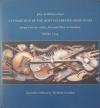
|
Sources for Gaelic harp music
A Collection of the most Celebrated Irish Tunes proper for the violin, German Flute or Hautboy

Printed in Dublin by John and William Neal, 1724
This Irish printed book contains 49 tunes, one of which (Pléaráca na Ruarcach) is set with a bass, an Italianate setting credited to Lorenzo Bocchi. Many of the tunes are by Carolan, though a number are not attributed to him here. Other tunes are from the harp repertory.
The book is printed on one side of the paper only. Apart from three pages which are facing to minimise page turns, the music is printed on the rectos and the versos are blank.
Only one copy is known to survive, that owned by Edward Bunting and now preserved with his manuscripts in Queen’s University Library (special collections 4/31).
The Neales also printed many other books in Dublin, mostly editions of popular baroque and classical music. Their Collection of the most celebrated Scotch tunes for the violin... of c.1724 containes a version of Port Gordon (p.26b). As far as I am aware only one copy exists, bound together with the Celebrated Irish tunes in the Bunting manuscripts in Queens University Belfast; no facsimile or edition of the Celebrated Scotch tunes has been issued.
Editions and Facsimiles
Online edition, in Sibelius Scorch format, from Na Píobairí Uilleann.

A facsimile edition by Nicholas Carolan was published in 1986 by the Folk Music Society of Ireland / Cumann Cheol Tire Eireann, second edition Irish Traditional Music Archive 2010. In stock in the Emporium.
Gaelic harp tunes in this book
This is a complete contents list; some of the tunes are song airs but all of them are likely to have formed part of the repertory of early 18th century Irish harpers.
p.2 King of the Blind
Other versions: Pádraig Ó Néill ms2 p.9: Carelon or King of the Blind
p.2 Ye Clarges Lamentation
Other versions: : none known
p.3 Sqr. Woodes’s Lamentation on ye Refusall of his HALF PENCE
Usually attributed to Carolan
p.3 Da mihi manum (more info...)
This is the usual 18th century set, similar to the version in Burk Thumoth,
Oswald, &
Bunting as well as many other 18th century Irish and Scottish mss and printed books, but different from the versions in Wemyss,
MacFarlane, Dow &
Balcarres.
p.4 Thomas Burk
Usually attributed to Carolan
Other versions: Bunting ms29: Sir Thomas Bourk
p.4 Eiry na Greany
p.5 Molly Halfpenny
Usually attributed to William Connellan
Other versions: Bunting:
p.5 Planksty Plunket
Usually attributed to Carolan
p.6 Plea Rarkeh na Rourkough or ye Irish weding improved with diferent divitions after ye Italian maner with A bass and Chorus by sigr. LORENZO BOCCHI
Usually attributed to Carolan
Other versions: Bunting: Lee: Ple Raca na Rourkaugh;
p.10 Counr. MacDonoghs Lamentation
Usually attributed to Carolan
Other versions: Bunting: Oswald: Mc. Donogh’s Lamentation
p.10 Shea sude shear an Rode a Dima shee
p.11 Capten MAGAN
Usually attributed to Carolan
Other versions: Bunting:
p.11 Creamonea
Usually attributed to Carolan
p.11 Tom Judge
Usually attributed to Carolan
p.12 Ta me ma Chulla’s na doushe me
Táim i mo Chodladh in Bunting ms29; Burk Thumoth etc.
p.12 Radara meen Chusogh
p.13 Fairy Queen by sigr Carrollini
Other versions: Carolan Fragment: ; Pádraig Ó Néill ms2 p.17: C Fairy Queen; etc. See my notes on the Fairy Queen.
p.14 MABLE KELLY
Usually attributed to Carolan
Other versions: Bunting ms33(3): ; Pádraig Ó Néill ms2 p.19: C Mable Kelly;
p.14 Cuckoo
Usually attributed to Carolan, wrongly in my opinion. This is part of a complex family of tunes titled "sheebeg is sheemore", "the Bonny Cuckoo", etc. See my notes on the Cuckoo.
Other versions: Maclean-Clephane ms: Cuckoo; etc.
p.14 Ishabele Burk
Usually attributed to Carolan
p.15 Raddire en Ougnish
p.15 Catty Magee
p.16 Can duh Dilish
Other versions: Bunting:
p.16 Seperation of soul and Body
Usually attributed to Carolan
p.17 Sheen sheesh igus souse lum
p.17 Vaccatu en starri dugh
Other versions: Bunting ms 33(2): Bhacca Dubh en Starrae Dubh Gera'm Mna
p.17 ye Joynter
p.18 Challeeny vacca shu sheorshe
Usually attributed to Cornelius Lyons. It seems to me that this variation set is a version of the Lyons set played by Denis O'Hampsey (though Nicholas Carolan says in his book that it is not related)
Other versions: Bunting ms29:
p.19 Clanuff’s delight
p.20 Luke Dillon by Carrollan
Usually attributed to Carolan
Other versions: Bunting:
p.20 Voyden drid lum
p.21 PLANKSTY
Usually attributed to Carolan
Other versions: Bunting: Plangsty Burke; Carolan Fragment: Plansty Bourk
p.21 Shuseen Bane
p.22 Carrollans Devotion
Usually attributed to Carolan
p.22 Ld. Gallaways Lamentation
Other versions: Oswald: Gallaways Lament; Sinkler: Gallway's Lament
p.22 Lady St. John
p.23 Morgan Mac gann
Usually attributed to Carolan
Other versions: Bunting ms 33(2):
p.24 Molly St. GEORGE
Usually attributed to Thomas Connellan
Other versions: Bunting:
p.24 Gye Fiane
This is part of the cycle of King James March to Ireland tunes.
Other versions: Bunting ms 33(1): Wild Geese, or Ireland's Lamentation
p.25 Sr Vlick BVRK
Usually attributed to Carolan
Other versions: Bunting ms 33(2):
p.25 Limbrick’s lamentation
This is part of the cycle of King James March to Ireland tunes.
Other versions: Bunting ms 33(1): Lochaber
p.26 Gracee NVGENT by Carrallan
p.26 ye Bockagh
Usually attributed to Ruaidhrí Dall Ó Catháin
Other versions: Bunting:
p.26 Patrick Sarsfild
p.27 ye RAGG set by A gentleman
p.28 Fanny DILLON
Usually attributed to Carolan
Other versions: Bunting ms 33(2):
p.28 ye Lord Mayos delight
Usually attributed to Thady Keenan or David Murphy
Other versions: Bunting:
p.29 Stary ghed ma lousa Voem
A Stáraí a ghoid mo chlú-sa uaim, attributed to Thomas Connellan. Presumably "The Golden Star" is a phonetic mangling of the Irish A Stáraí a ghoid
Other versions: Bunting: The Jointure or the Golden Star.
p.29 gigga
Jig to the above
p.29 ye Trugh
Simon Chadwick